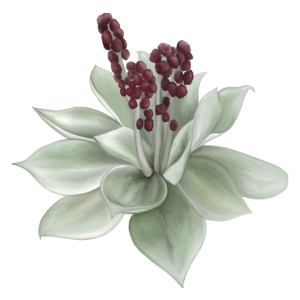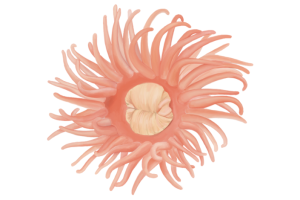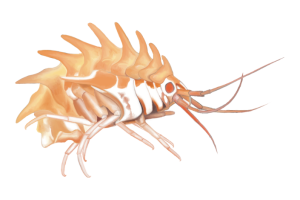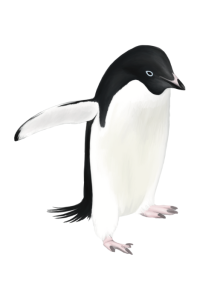Antarctic Biodiversity
Meet some of our favourite Antarctic species.

Weevil (Bothrometopus randi)
Bothrometopus randi is a relatively large (9mm long) beetle within the insect family of the weevils (Curculionidae). A closer look, usually with a microscope, reveals its shiny body covered with small green and brown scales. Bothrometopus randi is part of the unique biodiversity living on the sub-Antarctic Îles Crozet and Prince Edward Islands of the Southern Ocean, with their genetics indicating differences between the island groups.
Living in rocky habitat from sea level to higher elevations (up to 750m), it is usually found on rock faces and within fellfields. In these cold locations, the adults shelter within rock crevices or under overhanging vegetation and venture out when conditions are suitable to eat algae, lichens and mosses. On Marion Island this weevil is under threat from the introduced mice that eat them. SAEF is working to further our understanding of Bothrometopus randi along with the many other insects that live on the Southern Ocean Islands to work to secure their future.
— Naomi Monk, PhD Student

Silver-leaf Daisy (Pleurophyllum hookeri)
Pleurophyllum hookeri is a herbaceous plant species found only on the sub-Antarctic islands of Auckland Island, Campbell Island, and Macquarie Island. It is one of the unique ‘megaherb’ species which are endemic to the sub-Antarctic region, so named for their large, thick leaves and often tall stature. This species can often be found in abundance on these islands, where it forms lush meadows.
P. hookeri has a number of features which make it well adapted to the sub-Antarctic climate. The silvery leaves of P. hookeri are densely covered in small hairs which help to trap heat and increase photosynthetic rates. These leaves can grow up to 60cm long, forming large rosettes which act as solar panels to help to concentrate radiant energy towards the growing part of the plant. To maintain these structures under the strong and persistent winds of the sub-Antarctic, P. hookeri has evolved a very short, largely underground stem to anchor it in the ground.
— Sam Beale, PhD Candidate

Springtail (Gomphiocephalus hodgsoni)
Springtails are tiny marvels of the natural world; they often dance unnoticed in the tapestry of our daily lives. These are true giants in the functioning of our ecosystems, by enhancing soil health and serving as prey for small predators. Found on all seven continents – some even thrive in scattered pockets of soil amidst permanent ice at the southern end of the world.
Among the twelve species of springtails, that call the Antarctic continent their only home, is Gomphiocephalus hodgsoni, named in honour of T.M. Hodgson, a biologist who ventured on the H.M.S. Discovery from 1901 to 1904. This species, though widespread, is restricted to the southern Victoria Land within the Ross Sea sector. With the average size of only 1.3 mm, they are extremely resilient and have survived in isolated refuges for millions of years on this hostile, yet fragile, continent. By studying their histories, we learn about past environmental changes and how they might respond to the future changes of our planet.
— Dr Amy W.P. Liu, Research Fellow

Anemone (Urticinopsis antarctica)
Widespread at shallow depths along the Antarctic and sub-Antarctic coastline is Urticinopsis antarctica, a sea anemone living a sedentary and solitary life on the ocean floor. Like other anemones, U. antarctica can be recognised by its beautiful but deadly tentacle crown. Whorls of long, slender tentacles contain explosive stinging capsules that can stun and intercept prey and defend against predators. Passers-by should beware – this carnivorous creature is not fussy and will eat almost anything that can be captured and consumed, be it molluscs, sea stars, or even other anemones.
— Laura Phillips, Research Assistant

Amphipod (Epimeria rubrieques)
Amphipods are small crustaceans that play an important role in aquatic ecosystems. They are broad consumers, either as herbivores feeding on algae, predators feeding on other invertebrates, and/or detritivores feeding on dead animals. They also play an important role as prey themselves for other animals.
Epimeria rubrieques sp., named after the German “der rote Ritter” meaning the red knight, is a cold-water marine species first discovered in 1983 in the Weddell Sea. It is characterized by its bright red colour, prominent dorsal spikes and large body size, growing up to 7 cm. This species is likely an ambush predator, and could spend hours a day resting on the bottom of the seafloor only becoming active when it finds food.
— Noemie Sheppard, PhD Student

Wandering Albatross (Diomedea exulans)
The Wandering Albatross (Diomedea exulans) is one of the largest seabirds with a wingspan of up to 3.5 m which is often considered to be the largest of all birds. Only the Southern Royal Albatross (Diomedea epomophora) is similar in size.
Wandering Albatrosses are found in the windiest oceans of the southern hemisphere and spend most of their life at sea, where they cover vast distances foraging for cephalopods (such as squid), fish, and crustaceans. They breed every two years and their chicks reach maturity slowly but can live for over 80 years.
The Wandering Albatross formerly included several subspecies, but these are now usually treated as distinct species. To avoid confusion, the Wandering Albatross is often also called the Snowy Albatross, after the extensive, clean white plumage shown by old males. It breeds on islands in the southern Atlantic and Indian Ocean, and on Macquarie Island.
The other former subspecies of the Wandering Albatross are the Tristian Albatross (which breeds on Gough and Tristan Island), Amsterdam Albatross (which breeds on Amsterdam Island) and on the Gibson’s Albatross and Antipodean Albatross (which breed on the sub-Antarctic islands of New Zealand).
— Dr Matthias Dehling, Research Fellow

Adelie Penguin (Pygoscelis adeliae)
The Adélie penguin (Pygoscelis adeliae) is one of the most widespread species of penguin in the Antarctic. They breed in the summer months, returning to the same location they were hatched at and to the same mate each year. They make nests for their eggs in ice-free areas of the Antarctic coast using small stones and guano. In April, when the chicks are old enough, they migrate north where the weather is warmer. Adélie penguin’s eat small fish, krill, and amphipods, and while in the water can hold their breath for up to six minutes and can dive as deep as 180 meters. One of the key ways you can distinguish an Adélie penguin from other penguins is the white ring around their eye.
— Madison Farrant, PhD Student
This series of Antarctic biodiversity stickers celebrates the icons, the rising stars and the important role-players in the region’s ecosystems.
With thanks to Dr Ellie Hay for the illustrations.